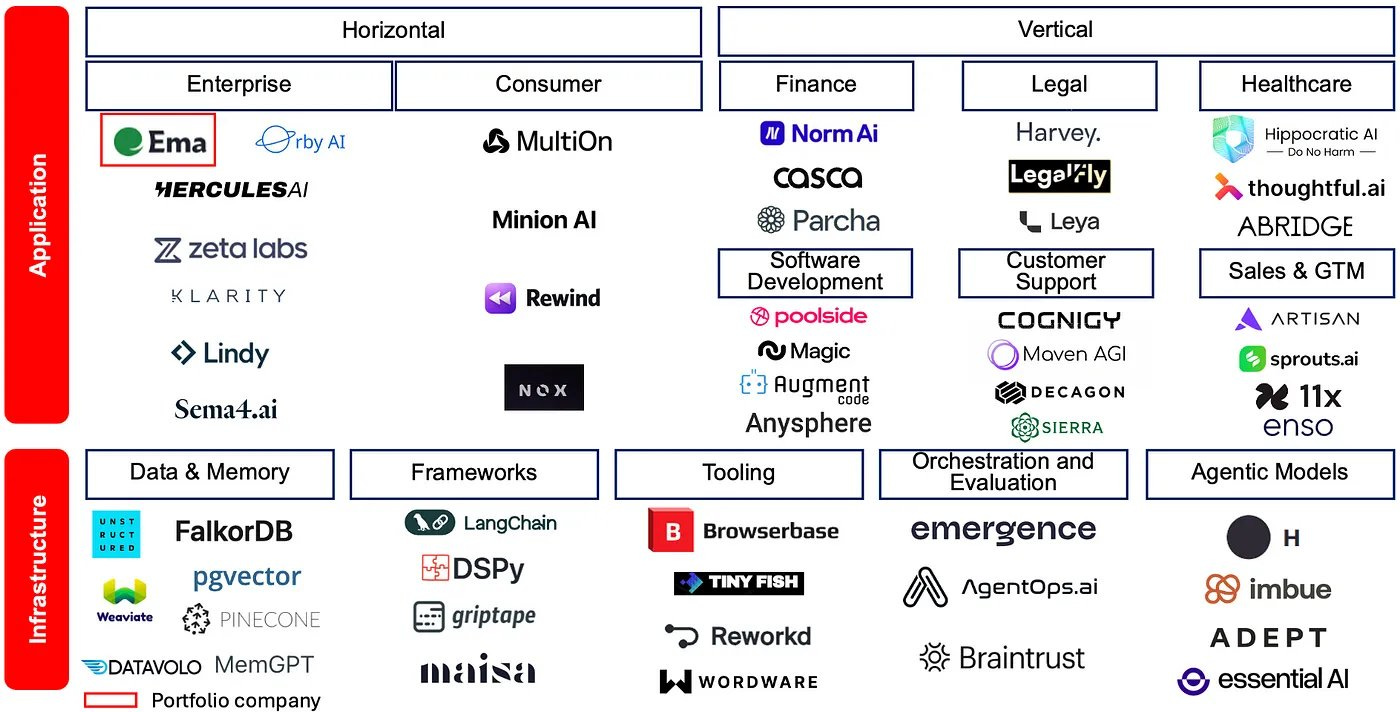Your pocket crystal ball for navigating the treacherous waters of AI entrepreneurship, where the sharks have PhDs and the lifeguards are all venture capitalists with itchy investment fingers.
Remember when chatbots were novel?
Now my toaster has an API and my cat's litterbox offers existential advice on the meaning of life (42 is of course the answer) while analyzing waste patterns.
Welcome to 2025, where AI is both everywhere and nowhere simultaneously—a quantum state of technological Schrödinger's cat, simultaneously revolutionary and utterly underwhelming.
The Truth About Today's AI Landscape
Most AI implementations today?
Just expensive magic 8-balls with better marketing.
They're digital fortune tellers dressed in Silicon Valley's finest buzzwords, charging enterprise rates for answers only marginally more sophisticated than "Reply hazy, try again."
But beneath the algorithmic snake oil and venture capital froth lies an emerging blueprint for genuinely transformative AI-first companies.
It's time to separate the digital wheat from the computational chaff.
The Agent Market Treasure Map
Adam Silverman's Agent Market Map update isn't just another industry infographic destined to decorate a forgotten slide deck—it's a treasure map with X marking multiple spots where fortunes await the perceptive founder.
What most miss about this map is what's between the nodes. The AI agent ecosystem isn't overcrowded; it's misconfigured—like a neural network with faulty connection weights.
The opportunity isn't in creating the 21st AI writing assistant, but in reconfiguring the synaptic architecture connecting existing solutions.
The Architect's View: The system architecture of tomorrow's successful AI companies won't resemble today's monolithic platforms, but rather synaptic networks where value flows multidirectionally.
Your AI startup shouldn't be a fortress; it should be a neural junction. In the end, with the advent of AI super engineers, anybody would be able to create his own AI SaaS / AI Agent system.
But those who will be filling the gaps, blending capabilities, have vertical domain data and owning their audience →
They will survive as companies.
Consider the following framework I'm calling the "Integration Arbitrage Matrix":
As the ancient AI proverb goes (which I just invented):
"The lone startup dies, but the ecosystem survives."
Popularity ≠ Profitability: The GenAI Paradox
Olivia Moore and Daisy Z.'s illuminating "Top 100 GenAI Apps" list reveals something curious: popularity and profitability have a relationship status best described as "it's complicated."
I've analyzed their top 20 picks and found something startling: the most downloaded AI apps averaged 8.3x more users but 2.7x less revenue per user than the most profitable ones.
It's like having a stadium full of fans who all snuck in through the back door.
The Provocateur's Challenge: Your mission isn't to mimic what's viral but to forensically deconstruct why it succeeded. The GenAI graveyard is already filling with yesterday's viral sensations.
Let me share the "Sustainable AI Engagement Framework" I've developed:
User Acquisition: Is it driven by novelty or necessity?
Retention Mechanics: Does your AI solve an ongoing need or a one-time curiosity?
Value Creation: Are you enhancing core workflows or creating delightful distractions?
Monetization Logic: Does payment align with delivered value or perceived magic?
For every AI product that achieves escape velocity from the hype cycle, hundreds burn up on reentry to market reality. The difference isn't the product; it's the mission.
Vibe Revenue: The Emperor's New Neural Network
Greg Isenberg's concept of "Vibe Revenue" is perhaps the most important cautionary tale in today's AI gold rush. It's that deceptive early traction fueled by novelty rather than necessity—the digital equivalent of a sugar high before the inevitable crash.
I've seen startups celebrate their first million in revenue only to discover it was just the collective "let's try this new thing" budget of curious corporations. Six months later, they're wondering why renewals look like a flatlined EKG.
The Navigator's Guidance: Don't mistake short-lived AI hype revenue for true ARR—which in 2025 should stand for "Annual Recurring Relevance." Your financial models should distinguish between:
Vibe Revenue = Initial Curiosity × Current Hype Factor
versus
Sustainable Revenue = Persistent Problem × Solution Efficacy × Integration Depth
I recently consulted for a GenAI startup that reduced their projected first-year revenue by 70% after applying this formula.
Their investors initially panicked—until quarters 3 and 4 outperformed even their original projections because they focused on building sustainable value rather than chasing the dopamine hit of early hype adoption.
Enterprise Evolution: From Digital Filing Cabinets to Cognitive Ecosystems
Aaron Levie sees the enterprise future with enviable clarity: AI agents won't simply automate existing processes; they'll fundamentally transform enterprise DNA from passive systems of record to active systems of intelligence.
Imagine your company's data architecture as a brain. Today's enterprises resemble patients with severe amnesia—they have memories stored but can't access them meaningfully. Tomorrow's AI-powered organizations will develop a corporate consciousness, where insights flow as naturally as thoughts.
The Architect's Blueprint: Your startup must position itself as either a catalyst for this transformation or resign itself to irrelevance.
The enterprise software playbook of 2023 is already obsolete—like trying to win a Formula 1 race with a well-optimized horse full of vitamins.
The 225x Multiple Mirage
When Palle Broe identified AI companies commanding revenue multiples as high as 225x, he wasn't just documenting irrational exuberance—he was revealing a market collectively hallucinating.
These aren't valuations; they're financial fan fiction.
For context, even during the frothiest days of SaaS mania, top performers rarely exceeded 40x revenue multiples.
At 225x, you're not buying projected growth; you're buying a ticket to the AI Fantasyland theme park.
The Provocateur's Warning: The correction won't be a gentle descent but a gravitational reckoning. When investors suddenly remember that even AI companies must eventually produce cash, the market will perform a multiples compression so dramatic it should come with a soundtrack.
Your survival strategy?
Build as though your valuation is 5x revenue, even if investors are temporarily willing to pay 50x. Financial gravity always wins, usually right after your last funding round.
Beyond Data Silos
Anthropic's Model Context Protocol (MCP) is quietly reshaping AI's future in ways few have fully processed. It's not just another standard; it's a philosophical stance on how intelligence should interact with information.
The fragmented data silos of today—where your CRM doesn't really talk to your ERP which barely acknowledges your business intelligence tools—are dinosaurs watching the asteroid approach. MCP represents the extinction event.
The Navigator's Coordinates: Your opportunity lies in exploiting MCP to build radically interoperable platforms. The winners of 2027 are already laying these foundations today, creating ecosystems where data flows as freely as conversation at a cocktail party, rather than being locked in solitary confinement.
I've developed what I call the "DLM - Data Liberation Matrix" (of course it could also mean “Donate Lovely Money”) :
The defining characteristic of next-generation AI companies won't be their models, but their membranes—how permeable they are to information flow.
The Software Endgame: Beyond Applications
David Peterson's provocative thesis that we're approaching "the end state of software" isn't technological nihilism; it's evolutionary foresight.
Traditional software models—with their rigid features and update cycles—are the digital equivalent of Neanderthals: impressively adapted to a world that's rapidly disappearing.
The Architect's Vision: Don't be seduced by incrementalism. Your product strategy should leapfrog current capabilities by at least two generations. While your competitors debate feature improvements, reframe the entire paradigm.
Anyway, consider this prediction:
By 2027, 40% of enterprise software categories as currently defined will cease to exist as distinct markets, instead becoming features within integrated intelligence ecosystems.
ReflectionAI's Warning Shot
Misha Laskin's ReflectionAI represents something beyond iterative improvement—it's a harbinger of truly autonomous systems capable of introspection and self-improvement.
We're witnessing not just the birth of new tools, but new forms of cognitive architecture.
The Provocateur's Question: Is your startup prepared for a world where AI doesn't just assist decision-making but actively directs it? The companies that will thrive in this landscape are already building the guardrails, governance models, and philosophical frameworks required.
I call this the "Autonomous Readiness Scale":
Task Automation - Performing predefined actions
Decision Support - Providing insights for human choices
Delegated Authority - Making bounded decisions independently
Supervised Autonomy - Operating with human oversight
Strategic Intelligence - Defining and pursuing objectives
Directive Super Intelligence - Kinda Psychohistory style…
Most current AI falls between levels 1-3.
ReflectionAI is pushing into level 4, with clear sightlines to level 5.
Where does your roadmap lead?
Your Blueprint for Actually Intelligent Artificial Intelligence
The turbulent but exhilarating AI landscape of 2025 demands more than adaptation; it requires prescient architecture.
Here's your survival blueprint:
Build for Interoperability First - The value of your AI solution will increasingly be determined by what it can connect to, not just what it can do.
Solve for Trust, Not Just Capability - As models become commoditized, your competitive moat will be how much users trust your implementation.
Design Business Models for Sustainable Engagement - Structure pricing around ongoing value creation, not initial novelty.
Embrace Radical Transparency - The black-box approach to AI is dying. Users increasingly demand visibility into how decisions are made.
Develop an Ethical Framework Before You Need It - The companies that will survive regulation are already self-regulating.
Remember when the first iPhone appeared and most dismissed it as an expensive toy? ( I did not, I already received expensive HP smart phone brick two years before that!!! Yay!!! Love of the corporate can be really cruel:/)
Forget it.
We're not at the same inflection point with genuinely transformative AI. We are levels of magnitudes higher. If done right.
The noise is deafening, the signal faint—but for those with tuned receivers, the message is clear:
The future doesn't wait—it must be engineered.
And unlike your AI chatbot, I won't end with a cheerful "Is there anything else I can help you with today?"
Because we both know the real work begins after you finish reading.








Great again!!! :) Going to start the work as I finished the reading:)